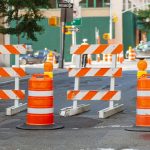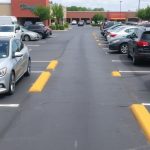Overview
Introduction to parking bumps
Parking bumps, also known as speed bumps or speed humps, are physical structures installed in parking lots to slow down vehicles. They are typically made of concrete or rubber and are strategically placed to ensure the safety of pedestrians and vehicles. The main purpose of parking bumps is to control the speed of vehicles, reduce the risk of accidents, and create a safer environment for everyone using the parking lot. In addition to enhancing safety, parking bumps also help in maximizing the efficiency of public parking lots by preventing reckless driving and encouraging drivers to follow the designated paths and parking spaces. By introducing parking bumps in public parking lots, parking lot operators can effectively manage traffic flow, reduce congestion, and optimize parking space utilization. Overall, parking bumps play a crucial role in improving the functionality and safety of public parking lots, making them an essential feature in modern parking lot design and management.
Purpose of the article
The purpose of the article is to explore the benefits of parking bumps in public parking lots and how they can maximize efficiency. Parking bumps, also known as speed bumps or traffic calming devices, are raised structures placed on the ground to slow down vehicles. They serve as a tool to control the speed of vehicles and improve safety in parking areas. This article aims to highlight the various advantages of using parking bumps, such as reducing accidents, improving traffic flow, and enhancing parking lot organization. By understanding the purpose and benefits of parking bumps, public parking lot managers can make informed decisions to optimize their parking facilities and create a safer environment for both drivers and pedestrians.
Benefits of using parking bumps
Parking lot bumps, also known as speed bumps or speed humps, offer numerous benefits when used in public parking lots. One of the main advantages is that they help maximize efficiency by controlling the speed of vehicles. By slowing down vehicles, parking bumps reduce the risk of accidents and improve overall safety in parking lots. Additionally, parking bumps can help regulate traffic flow and prevent drivers from speeding or driving recklessly. This not only improves the parking experience for users but also ensures a more organized and orderly parking environment. Overall, the use of parking bumps in public parking lots is an effective way to enhance efficiency and promote a safer parking experience.
Understanding Parking Bumps
Definition and types of parking bumps
Parking bumps, also known as speed bumps or speed humps, are raised structures placed on roads or parking lots to slow down vehicles and improve safety. They are typically made of concrete or asphalt and are designed to provide a physical barrier that forces drivers to reduce their speed. Parking bumps come in various types, including speed humps, which are wider and flatter, and speed bumps, which are taller and narrower. These different types of parking bumps serve different purposes and are installed based on the specific needs of the parking lot. Overall, parking bumps play a crucial role in maximizing efficiency and safety in public parking lots.
How parking bumps are installed
Parking bumps, also known as speed bumps or speed humps, are installed in public parking lots to enhance safety and optimize traffic flow. These bumps are typically made of durable materials such as concrete or rubber and are designed to slow down vehicles by creating a gentle incline. The installation process involves determining the appropriate location for the bumps, marking the area, excavating the surface, and securely anchoring the bumps in place. By strategically placing parking bumps, parking lot operators can effectively control vehicle speed, reduce the risk of accidents, and ensure a smoother parking experience for all users.
Importance of proper installation
Proper installation of parking bumps is crucial for maximizing efficiency in public parking lots. These bumps serve as physical barriers that help guide drivers and prevent them from parking in unauthorized areas or encroaching on pedestrian walkways. By strategically placing parking bumps in designated parking spaces, parking lot operators can ensure that vehicles are parked in an orderly manner, maximizing the use of available space. Additionally, proper installation of parking bumps helps to enhance safety by reducing the risk of accidents and collisions within the parking lot. Overall, the importance of proper installation of parking bumps cannot be overstated, as it plays a key role in optimizing the functionality and safety of public parking lots.
Enhancing Safety with Parking Bumps
Preventing accidents and collisions
Parking bumps, also known as speed bumps or speed humps, play a crucial role in preventing accidents and collisions in public parking lots. These raised structures are strategically placed to slow down vehicles and encourage drivers to be more cautious while navigating through the parking area. By forcing drivers to reduce their speed, parking bumps help minimize the risk of accidents caused by reckless driving or speeding. Additionally, they serve as a visual reminder for pedestrians to exercise caution when crossing the parking lot. Overall, the presence of parking bumps contributes to a safer and more efficient parking experience for both drivers and pedestrians.
Improving visibility for drivers
Improving visibility for drivers is a key aspect of maximizing efficiency in public parking lots. By strategically placing parking bumps in designated areas, drivers are able to easily navigate and locate available parking spaces. These bumps serve as visual indicators, guiding drivers towards open spots and ensuring that the parking lot is utilized to its full capacity. Additionally, the increased visibility provided by these bumps helps to prevent accidents and promotes a safer parking environment for both drivers and pedestrians. Overall, the implementation of parking bumps plays a crucial role in improving the overall efficiency and functionality of public parking lots.
Reducing speeding in parking lots
Speeding in parking lots is a common problem that poses a risk to both pedestrians and vehicles. However, by implementing parking bumps, this issue can be effectively addressed. These bumps, also known as speed bumps or speed humps, are raised structures placed strategically in parking lots to slow down vehicles. By forcing drivers to reduce their speed, parking bumps help create a safer environment for everyone. They encourage drivers to be more cautious and attentive, reducing the likelihood of accidents and injuries. Additionally, parking bumps can also help to control traffic flow and prevent reckless driving in parking lots. Overall, the installation of parking bumps is an effective measure in reducing speeding and improving safety in public parking lots.
Optimizing Space Utilization
Maximizing parking capacity
One effective way to maximize parking capacity in public parking lots is by implementing parking bumps. Parking bumps, also known as speed bumps or speed humps, are raised structures placed strategically in parking lots to slow down vehicles. By installing parking bumps, the flow of traffic in parking lots can be regulated, preventing speeding and reckless driving. This not only improves safety but also increases the number of available parking spaces. Parking bumps encourage drivers to drive at a slower speed, allowing for more efficient use of the parking lot and reducing the risk of accidents. Additionally, parking bumps can help to organize the parking spaces, ensuring that vehicles are parked in an orderly manner and maximizing the use of available space. Overall, the implementation of parking bumps is an effective solution to maximize the efficiency of public parking lots and provide a safer and more organized parking experience for users.
Organizing parking spaces effectively
Parking lots can be chaotic and confusing, especially in busy areas. However, by organizing parking spaces effectively, the efficiency of public parking lots can be maximized. One way to achieve this is through the use of parking bumps. These small raised structures are strategically placed in parking spaces to guide drivers and ensure that vehicles are parked in a uniform manner. By providing clear boundaries, parking bumps help prevent parking space encroachment and allow for more efficient use of available space. Additionally, they promote safety by reducing the risk of accidents and collisions. Overall, organizing parking spaces effectively with the help of parking bumps can greatly improve the functionality and convenience of public parking lots.
Creating designated areas for different vehicles
Creating designated areas for different vehicles is a crucial step in maximizing efficiency in public parking lots. By clearly marking and separating areas for cars, motorcycles, bicycles, and other types of vehicles, parking lot operators can ensure that each vehicle type has a designated space. This not only helps to prevent congestion and confusion but also allows for easier navigation and organization within the parking lot. Additionally, creating designated areas for different vehicles promotes safety and security by reducing the risk of accidents and theft. Overall, implementing designated areas for different vehicles is a practical and effective way to enhance the efficiency and functionality of public parking lots.
Improving Traffic Flow
Directing traffic in parking lots
Parking bumps play a crucial role in directing traffic in parking lots. These bumps are strategically placed to guide vehicles and ensure a smooth flow of traffic. By creating designated lanes and pathways, parking bumps help prevent congestion and confusion among drivers. They serve as a visual cue for drivers to follow, indicating the correct direction to navigate within the parking lot. Additionally, parking bumps also help in organizing parking spaces, ensuring that vehicles are parked in an orderly manner. Overall, the presence of parking bumps greatly contributes to maximizing efficiency in public parking lots.
Reducing congestion and gridlock
Reducing congestion and gridlock is a key objective for public parking lots, and parking bumps play a significant role in achieving this goal. By strategically placing parking bumps in appropriate areas, traffic flow can be better managed, ensuring that vehicles are parked in an organized manner. This helps to prevent congestion and gridlock by providing clear pathways for vehicles to enter and exit the parking lot. Additionally, parking bumps discourage reckless driving and speeding, as they serve as physical barriers that encourage drivers to slow down and navigate the parking lot more cautiously. Overall, the presence of parking bumps in public parking lots contributes to a smoother and more efficient parking experience, benefiting both drivers and the community as a whole.
Enhancing navigation for drivers
Public parking lots can greatly benefit from the installation of parking bumps, which enhance navigation for drivers. These bumps, also known as speed bumps or speed humps, are raised sections of pavement designed to slow down vehicles and improve safety. By strategically placing parking bumps throughout the parking lot, drivers are encouraged to drive at a slower speed, reducing the risk of accidents and improving overall traffic flow. Additionally, parking bumps help to clearly define driving lanes and parking spaces, making it easier for drivers to navigate and find available parking spots. Overall, the use of parking bumps in public parking lots can maximize efficiency and enhance the overall parking experience for drivers.
Conclusion
Summary of the benefits of parking bumps
Parking bumps, also known as speed bumps or speed humps, offer several benefits for public parking lots. Firstly, they help to control the speed of vehicles entering and exiting the parking lot, reducing the risk of accidents and ensuring the safety of pedestrians. Additionally, parking bumps can help to maximize the efficiency of parking spaces by encouraging drivers to park in designated areas and preventing them from taking up multiple spaces. This not only improves the overall flow of traffic within the parking lot but also increases the number of available parking spots. Furthermore, parking bumps can act as a visual deterrent for unauthorized parking, discouraging people from parking in areas reserved for specific individuals or businesses. Overall, the implementation of parking bumps in public parking lots can greatly enhance safety, efficiency, and organization.
Importance of implementing parking bump strategies
Implementing parking bump strategies is crucial for maximizing efficiency in public parking lots. These strategies, which involve the installation of raised barriers at the end of parking spaces, offer numerous benefits. Firstly, parking bumps help to prevent vehicles from encroaching into adjacent spaces, ensuring that each vehicle is properly parked within its designated area. This not only increases the overall capacity of the parking lot but also reduces the chances of accidents or damage to vehicles. Additionally, parking bumps promote organized parking by providing clear boundaries for drivers, making it easier for them to navigate and find available spaces. By implementing parking bump strategies, public parking lots can effectively manage their space, improve traffic flow, and enhance the overall experience for drivers.
Future developments in parking bump technology
Future developments in parking bump technology are aimed at further enhancing the efficiency and effectiveness of public parking lots. One key area of focus is the integration of smart sensors into parking bumps, allowing for real-time monitoring of parking spaces. These sensors can detect the presence of vehicles and provide accurate information on parking availability, reducing the time spent searching for a parking spot. Additionally, advancements in materials and design are being explored to create parking bumps that are more durable, weather-resistant, and visually appealing. The goal is to create a seamless parking experience for drivers, ensuring maximum efficiency and convenience in public parking lots.







